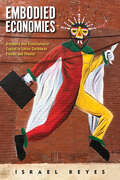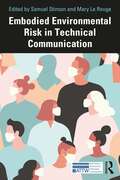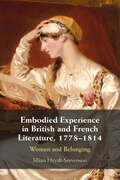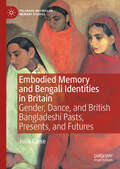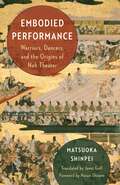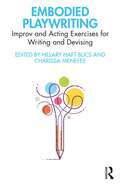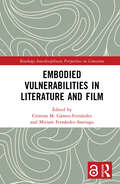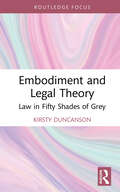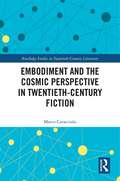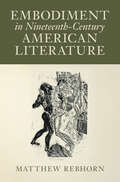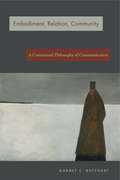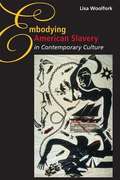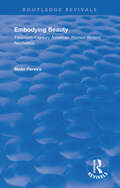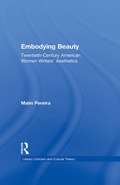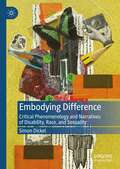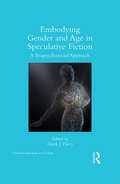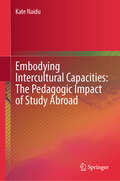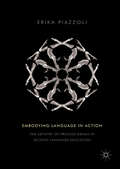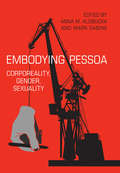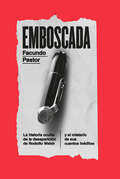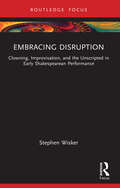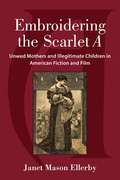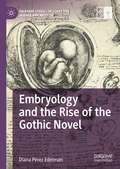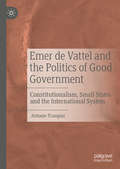- Table View
- List View
Embodied Economies: Diaspora and Transcultural Capital in Latinx Caribbean Fiction and Theater (Latinidad: Transnational Cultures in the United States)
by Israel ReyesHow do upwardly mobile Latinx Caribbean migrants leverage their cultural heritage to buy into the American Dream? In the neoliberal economy of the United States, the discourse of white nationalism compels upwardly mobile immigrants to trade in their ties to ethnic and linguistic communities to assimilate to the dominant culture. For Latinx Caribbean immigrants, exiles, and refugees this means abandoning Spanish, rejecting forms of communal inter-dependence, and adopting white, middle-class forms of embodiment to mitigate any ethnic and racial identity markers that might hinder their upwardly mobile trajectories. This transactional process of acquiring and trading in various kinds of material and embodied practices across traditions is a phenomenon author Israel Reyes terms “transcultural capital,” and it is this process he explores in the contemporary fiction and theater of the Latinx Caribbean diaspora. In chapters that compare works by Lin-Manuel Miranda, Nilo Cruz, Edwin Sánchez, Ángel Lozada, Rita Indiana Hernández, Dolores Prida, and Mayra Santos Febres, Reyes examines the contradictions of transcultural capital, its potential to establish networks of support in Latinx enclaves, and the risks it poses for reproducing the inequities of power and privilege that have always been at the heart of the American Dream. Embodied Economies shares new perspectives through its comparison of works written in both English and Spanish, and the literary voices that emerge from the US and the Hispanic Caribbean.
Embodied Environmental Risk in Technical Communication: Problems and Solutions Toward Social Sustainability (ATTW Series in Technical and Professional Communication)
by Samuel StinsonThis collection calls for improved technical communication for the public through an embodied, situated understanding of environmental risk that promotes social justice. In addition to providing a series of chapters about recent issues on risk communication, this volume offers a diverse look at methodological practices for students, researchers, and practitioners looking to address embodied aspects of crisis and risk that incorporate UX, storytelling, and dynamic text. It includes chapters that bring embodiment to the forefront of risk communication, highlighting the cycle of content creation, dissemination, public response and decision making, continuing iterations of educational efforts, and recovery, toward increasing adaptive capacity as a whole. In addition, this work directs necessary attention to overcoming perceptual difficulties, memory lapses, definitional differences, access issues, and pedagogical problems in the communication of risks to diverse publics. This collection is essential reading for scholars and can be used as a supplemental text or casebook for courses in technical communication, environmental communication, risk and crisis communication, science communication, and public health.
Embodied Experience in British and French Literature, 1778–1814: Women and Belonging
by Jillian Heydt-StevensonCombining feminist, materialist, and comparatist approaches, this study examines how French and British women writers working at a transformative time for European literature connected vibrantly to objects as diverse as statues, monuments, diamonds, and hats. In such connections, they manifested their own (often forbidden) embodiment and asserted their élan vital. Interweaving texts by Edgeworth, Staël, Bernardin, Wordsworth, Smith, and Burney, Jillian Heydt-Stevenson posits the concept of belonging with, a generative, embodied experience of the nonhuman that foregrounds the interdependence among things, women, social systems, and justice. Exploring the benefits such embodied experiences offer, this book uncovers an ethical materialism in literature and illuminates how women characters who draw on things can secure rights that laws neither stipulate nor safeguard. In doing so, they-and their texts-transcend dualistic thinking to create positive ecological, personal, and political outcomes. This title is also available as Open Access on Cambridge Core.
Embodied Memory and Bengali Identities in Britain: Gender, Dance, and British Bangladeshi Pasts, Presents, and Futures (Palgrave Macmillan Memory Studies)
by Julia GieseThis book provides insight into the relationship between embodied processes and products of remembering and belonging among British Bangladeshi women in Tower Hamlets, London. Based on an analysis of memories performed in both professional and social dancing among British Bangladeshi women, as well as of the spaces and encounters that enable the production, transmission, and negotiation of such memories, this book addresses questions about the relationship between remembering and identification in the diaspora.
Embodied Performance: Warriors, Dancers, and the Origins of Noh Theater
by 1 Shinpei MatsuokaIn this groundbreaking book, Matsuoka Shinpei—a leading scholar of noh theater—provides a detailed account of the birth of one of Japan’s most celebrated art forms. Although noh has often been associated with the elite, Embodied Performance explores its links to a wider popular culture, revealing a rich and colorful public space where courtiers and commoners mingled.Matsuoka traces noh’s connections to popular and religious dances, linked verse, and chigo (beautiful temple boy) culture, emphasizing performance and the body. He describes the world of noh playwright Zeami as well as his views on dramaturgy and performance—and argues that Zeami was once a chigo. Matsuoka shows how religious rituals and cultural forms like ecstatic dance prayer and plays about demons in hell attracted people on the margins. Such activities, Matsuoka contends, drew on the tension between wild acrobatic movement and corporeal restraint, influencing the development of noh as well as the art of flower arranging and the tea ceremony. Janet Goff’s translation makes available in English a classic work of Japanese scholarship that will be invaluable to those interested in medieval Japanese culture, noh, and theatrical practice.
Embodied Playwriting: Improv and Acting Exercises for Writing and Devising
by Hillary Haft Bucs Charissa MenefeeEmbodied Playwriting: Improv and Acting Exercises for Writing and Devising is the first book to compile new and adapted exercises for teaching playwriting in the classroom, workshop, or studio through the lens of acting and improvisation. The book provides access to the innovative practices developed by seasoned playwriting teachers from around the world who are also actors, improv performers, and theatre directors. Borrowing from the embodied art of acting and the inventive practice of improvisation, the exercises in this book will engage readers in performance-based methods that lead to the creation of fully imagined characters, dynamic relationships, and vivid drama. Step-by-step guidelines for exercises, as well as application and coaching advice, will support successful lesson planning and classroom implementation for playwriting students at all levels, as well as individual study. Readers will also benefit from curation by editors who have experience with high-impact educational practices and are advocates for the use of varied teaching strategies to increase accessibility, inclusion, skill-building, and student success. Embodied Playwriting offers a wealth of material for teachers and students of playwriting courses, as well as playwrights who look forward to experimenting with dynamic, embodied writing practices.
Embodied VulnerAbilities in Literature and Film (Routledge Interdisciplinary Perspectives on Literature)
by Miriam Fernández-Santiago Gámez-Fernández, Cristina MEmbodied VulnerAbilities in Literature and Film includes a collection of essays exploring the ways in which recent literary and filmic representations of vulnerability depict embodied forms of vulnerability across languages, media, genres, countries, and traditions in the late 20th and early 21st centuries. The volume gathers 12 chapters penned by scholars from Japan, the USA, Canada, and Spain which look into the representation of vulnerability in human bodies and subjectivities. Not only is the array of genres covered in this volume significant— from narrative, drama, poetry, (auto)documentary, or film— in fiction and nonfiction, but also the varied cultural and linguistic coordinates of the literary and filmic texts scrutinized—from the USA, Canada, Spain, France, the Middle East, to Japan. Readers who decide to open the cover of this volume will benefit from becoming familiar with a relatively old topic— that of vulnerability— from a new perspective, so that they can consider the great potential of this critical concept anew.
Embodiment and Legal Theory: Law in Fifty Shades of Grey
by Kirsty DuncansonThis book addresses the importance of the body in legal theory, through an analysis of the film Fifty Shades of Grey.As physical beings, we experience law in sensations of outrage when it is applied unethically, righteousness when it finds justice, and joy when it establishes partnerships in marriage. Our bodies feel and know law. In Embodiment and Legal Theory, it is argued that our bodies also theorise law. It is proposed that our bodies are involved in comprehending, negotiating, and reimagining the legal concepts that shape our lives. As a medium designed to engage us by stimulating our bodily reactions of tears, laughter, shock, and titillation, cinema provides an ideal site for exploring how bodies participate in legal arguments and the construction of legal meaning. For this reason, through a deep analysis of the film Fifty Shades of Grey (2015), this book presents a theory of embodied jurisprudence.At the intersection of legal theory and film studies, this book will appeal to students and scholars in both these areas, as well as in criminology and cultural studies.
Embodiment and the Cosmic Perspective in Twentieth-Century Fiction (Routledge Studies in Twentieth-Century Literature)
by Marco CaraccioloIn dialogue with groundbreaking technologies and scientific models, twentieth century fiction presents readers with a vast mosaic of perspectives on the cosmos. The literary imagination of the world beyond the human scale, however, faces a fundamental difficulty: if, as researchers in both cognitive science and narrative theory argue, fiction is a practice geared toward the human embodied mind, how can it cope with scientific theories and concepts— the Big Bang, quantum physics, evolutionary biology, and so on—that resist our common-sense intuitions and appear discontinuous, in spatial as well as temporal terms, with our bodies? This book sets out to answer this question by showing how the embodiment of mind continues to matter even as writers— and readers—are pushed out of their terrestrial comfort zone. Offering thoughtful commentary on work by both mainstream literary authors and science fiction writers (from Primo Levi to Jeanette Winterson, from Olaf Stapledon to Pamela Zoline), Embodiment and the Cosmic Perspective in Twentieth-Century Fiction explores the multiple ways in which narrative can radically defamiliarize our bodily experience and bridge the gap with cosmic realities. This investigation affords an opportunity to reflect on the role of literature as it engages with science and charts its epistemological and ethical ramifications.
Embodiment in Nineteenth-Century American Literature (Cambridge Studies in American Literature and Culture)
by Matthew RebhornThis book recovers an important set of American literary texts from the turn of the nineteenth century to the Civil War that focus on bodies that seem to have minds of their own. Artists such as Charles Brockden Brown, Robert Montgomery Bird, Edwin Forrest, Henry Box Brown, Elizabeth Stuart Phelps, and Herman Melville represented the evocative expressiveness of these literary bodies. With twitches and roars, flushes and blushes, these lively literary bodies shaped the development of American Literature even as they challenged the structures of chattel slavery, market capitalism, and the patriarchy. Situated within its historical context, this new story of nineteenth-century American Literature thus reveals how American literary expression-from novels to melodramas, from panoramas to magic tricks-represented less repressive, more capacious possibilities of conscious existence, and new forms of the human for those dehumanized in the nineteenth century.
Embodiment, Relation, Community: A Continental Philosophy of Communication
by Garnet C. ButchartIn this volume, Garnet C. Butchart shows how human communication can be understood as embodied relations and not merely as a mechanical process of transmission. Expanding on contemporary philosophies of speech and language, self and other, and community and immunity, this book challenges many common assumptions, constructs, and problems of communication theory while offering compelling new resources for future study.Human communication has long been characterized as a problem of transmitting information, or the “outward” sharing of “inner thought” through mediated channels of exchange. Butchart questions that model and the various theories to which it gives rise. Drawing from the work of Giorgio Agamben, Roberto Esposito, Jean-Luc Nancy, and Jacques Lacan—thinkers who, along with Martin Heidegger and Michel Foucault, have critiqued the modern notion of a rational subject—Butchart shows that the subject is shaped by language rather than preformed, and that humans embody, and not just use, the signs and contexts of interaction that form what he calls a “communication community.”Accessibly written and engagingly researched, Embodiment, Relation, Community is relevant for researchers and advanced students of communication, cultural studies, translation, and rhetorical studies, especially those who work with a humanistic or interpretive paradigm.
Embodiment, Relation, Community: A Continental Philosophy of Communication
by Garnet C. ButchartIn this volume, Garnet C. Butchart shows how human communication can be understood as embodied relations and not merely as a mechanical process of transmission. Expanding on contemporary philosophies of speech and language, self and other, and community and immunity, this book challenges many common assumptions, constructs, and problems of communication theory while offering compelling new resources for future study.Human communication has long been characterized as a problem of transmitting information, or the “outward” sharing of “inner thought” through mediated channels of exchange. Butchart questions that model and the various theories to which it gives rise. Drawing from the work of Giorgio Agamben, Roberto Esposito, Jean-Luc Nancy, and Jacques Lacan—thinkers who, along with Martin Heidegger and Michel Foucault, have critiqued the modern notion of a rational subject—Butchart shows that the subject is shaped by language rather than preformed, and that humans embody, and not just use, the signs and contexts of interaction that form what he calls a “communication community.”Accessibly written and engagingly researched, Embodiment, Relation, Community is relevant for researchers and advanced students of communication, cultural studies, translation, and rhetorical studies, especially those who work with a humanistic or interpretive paradigm.
Embodying American Slavery in Contemporary Culture
by Lisa WoolforkThis study explores contemporary novels, films, performances, and reenactments that depict American slavery and its traumatic effects by invoking a time-travel paradigm to produce a representational strategy of "bodily epistemology." Disrupting the prevailing view of traumatic knowledge that claims that traumatic events are irretrievable and accessible only through oblique reference, these novels and films circumvent the notion of indirect reference by depicting a replaying of the past, forcing present-day protagonists to witness and participate in traumatic histories that for them are neither dead nor past. Lisa Woolfork cogently analyzes how these works deploy a representational strategy that challenges the divide between past and present, imparting to their recreations of American slavery a physical and emotional energy to counter America's apathetic or amnesiac attitude about the trauma of the slave past.
Embodying Beauty: Twentieth-Century American Women Writers' Aesthetics
by Malin PereiraFirst Published in 2000. This study stands alone in pairing black and white American women writers across the twentieth century on the intertwined issues of female beauty and literary aesthetics. Other studies published during the late 1980s and early 1990s—such as Aldon Lynn Nielsen’s Reading Race: White American Poets and the Racial Discourse in the Twentieth Century (1988), Dana B. Nelson’s The Word in Black and White: Reading "Race" in American Literature, 1638-1867 (1992), Eric J. Sundquist’s To Wake the Nations: Race in the Making of American Literature (1993), and Laura Doyle’s Bordering on the Body: The Racial Matrix of Modern Fiction and Culture (1994)—have also engaged in the process of reading racialist discourse in white texts or in attempting to construct a dialogue between black and white texts. None, however, has been concerned with female beauty and literary aesthetics in relation to twentieth-century American women writers and race.
Embodying Beauty: Twentieth-Century American Women Writers' Aesthetics (Literary Criticism and Cultural Theory)
by Malin PereiraFirst Published in 2000. Routledge is an imprint of Taylor & Francis, an informa company.
Embodying Difference: Critical Phenomenology and Narratives of Disability, Race, and Sexuality
by Simon DickelThis book explores how phenomenological ideas about embodiment, perception, and lived experience are discussed within disability studies, critical race theory, and queer studies. Building on these disciplines, it offers readings of memoirs and novels that address the consequences of stigmatization and the bodily dimensions of social differences. The texts include Robert F. Murphy’s The Body Silent, Simi Linton’s My Body Politic, Rod Michalko’s The Two-in-One: Walking with Smokie, Walking with Blindness, three memoirs by Stephen Kuusisto, Vincent O. Carter’s The Bern Book, as well as two novels, Matthew Griffin’s Hide and Armistead Maupin’s Maybe the Moon. All of the texts discussed in this book negotiate the significance of bodily and perceptual habits, the influence of language and culture on embodiment, the importance of relationality and community, the severe effects of misrecognition, and the possibilities of emancipation and social recognition. Hence, they are read as pioneering contributions to the emerging field of critical phenomenology.
Embodying Gender and Age in Speculative Fiction: A Biopsychosocial Approach (Children's Literature and Culture)
by Derek J. ThiessFollowing scholarship on gender in science fiction, this book explores the limits of considering age as a social construction, positing that an acknowledgement of aged bodies necessarily changes the way we read both age and science fiction. The volume employs contemporary clinical psychology, the biopsychosocial model, to demonstrate that age is an important and neglected topic relevant to the study of speculative fiction. While gender offers a vocabulary, the biopsychosocial approach provides a method to consider age (and gender) as an embodied synthesis of physicality, psychology, and social environment. This respected model of clinical psychology allows a unique and innovative lens through which to read age and the body in literature. Thiess offers readings of established sf classics including Octavia Butler’s Parable series; Orson Scott Card’s Ender’s Game; and cyberpunk authors such as Bruce Sterling, Pat Cadigan, and Neal Stephenson, also exploring more mainstream speculative works including Stephanie Meyer’s Twilight series and Joss Whedon’s Firefly/Serenity. Visiting topics such as care work, sexuality, sport, and the military in these works, the book demonstrates that acknowledging a more fully embodied age is not only necessary for the individual subject, but will also enrich our understanding of other social categories, including gender and race. Taking a constructive—rather than adversarial—stance, this book does not merely question how much one can ethically and responsibly "bend" age, but suggests there is a great deal to learn when one explores those limits.
Embodying Intercultural Capacities: The Pedagogic Impact of Study Abroad
by Kate NaiduThis book examines the extent to which in-country education contributes to the development of intercultural capacities among students and investigates how this occurs. It examines the experiences of Australian university students participating in educational programs in Indonesia and critiques and extends notions of interculturality. The potential development of intercultural capacities is explored in relation to four key themes: pedagogy, temporality, home, and culture. The book demonstrates that interculturalisation is not an automatic or guaranteed result of simply being ‘immersed’ in-country, but rather involves an array of pedagogic processes (involving both human and non-human actors). It outlines the temporal dimensions of in-country education, examining the experience as part of a broader trajectory, involving significant moments, and a range of engagements with diverse temporal rhythms. The book concludes by exploring how students’ understandings of ‘culture’ and ‘cultural difference’ impact the way in which the study-abroad experience is navigated. Readers will gain a deepened understanding of how intercultural capacities develop, which can be applied to other educational contexts including schools, as well as corporate and not-for-profit settings. Those interested in sociology, particularly Bourdieusian analysis, will also benefit from this empirical application (and extension) of the notion of habitus in the context of student mobility. “This is a well conceptualized and beautifully written book that explores how study abroad programs can play an important role in equipping young people to navigate the super-diversity that has now become a critical feature of societies around the world. It shows how such programs have the potential to enhance intercultural capacities, especially when crafted in ways that are thoughtfully fashioned and carefully enacted.” — Fazal Rizvi, University of Melbourne Australia
Embodying Language in Action: The Artistry of Process Drama in Second Language Education
by Erika PiazzoliThis book explores embodiment in second language education, sociocultural theory and research. It focuses on process drama, an embodied approach that engages learners’ imagination, body and voice to create a felt-experience of the second language and culture. Divided into three parts, it begins by examining the aesthetic and intercultural dimension of performative language teaching, the elements of drama and knowing-in-action. The central part of the book examines issues related to play, emotions, classroom discourse and assessment when learning a language through process drama, in a sociocultural perspective. The third part is an analysis of the author’s qualitative research, which informs a subtle discussion on reflective practitioner methodology, learner engagement and teacher artistry. Each chapter includes a drama workshop, illustrating in practice what embodying language in action can look like when working with asylum seekers, adult learners with intellectual disabilities, pre-service teachers, international students and children involved in a Content and Language Integrated Learning (CLIL) programme. A unique combination of theory, research and reflective practice, this book provides valuable insights for teacher/artists, teacher educators and researchers in the fields of performative and sociocultural language learning.
Embodying Pessoa
by Anna Klobucka Mark Sabinehe multifaceted and labyrinthine oeuvre of the Portuguese poet Fernando Pessoa (1888-1935) is distinguished by having been written and published under more than seventy different names. These were not mere pseudonyms, but what Pessoa termed 'heteronyms,' fully realized identities possessed not only of wildly divergent writing styles and opinions, but also of detailed biographies. In many cases, their independent existences extended to their publication of letters and critical readings of each other's works (and those of Pessoa 'himself').Long acclaimed in continental Europe and Latin America as a towering presence in literary modernism, Pessoa has more recently begun to receive the attention of an English-speaking public. Embodying Pessoa responds to this new growth of interest. The collection's twelve essays, preceded by a general introduction and grouped into four themed sections, apply a range of current interpretative models both to the more familiar canon of Pessoa's output, and to less familiar texts - in many cases only recently published. As a whole, this work diverges from traditional Pessoa criticism by testifying to the importance of corporeal physicality in his heteronymous experiment and to the prominence of representations of (gendered) sexuality in his work.
Emboscada: La historia oculta de la desaparición de Rodolfo Walsh y el misterio de sus cuentos inéditos
by Facundo PastorFacundo Pastor reconstruye la emboscada que terminó hace 45 años con la desaparición de Rodolfo Walsh, en la que no faltan doble agentes, traiciones y documentos de inteligencia militar, ocultos hasta hoy. Y también desentraña otro misterio: el destino de algunos cuentos del periodista, que aún, y como su cuerpo, siguen sin aparecer. Aquel mediodía del 25 de marzo de 1977, hace 45 años, Rodolfo Walsh llegó puntual a una cita que tenía programada en la esquina de las avenidas San Juan y Entre Ríos, en el centro de la ciudad de Buenos Aires. La reunión había sido confirmada respetando los códigos de seguridad de la clandestinidad: contraseñas secretas y chequeos telefónicos. No sabía que, en verdad, un operativo, que incluía un francotirador, lo estaba esperando para capturarlo. En esta investigación, Facundo Pastor reconstruye, con ritmo de novela policial, cómo se armó la emboscada que terminó con la desaparición de Rodolfo Walsh, en la que no faltan dobles agentes, traiciones y una serie de documentos desclasificados de inteligencia militar que permanecían secretos hasta este libro. Y también intenta desentrañar otro misterio: el destino de los papeles personales y algunos cuentos del periodista que aún hoy, y como su cuerpo siguen sin aparecer.
Embracing Disruption: Clowning, Improvisation, and the Unscripted in Early Shakespearean Performance (Routledge Advances in Theatre & Performance Studies)
by Stephen WiskerThis volume celebrates the centrality of clowning in Shakespeare’s conception of theatre and explores how he purposefully invited the clown’s anarchic energy into the heart of his dramaturgy.Clowning was a potent but divisive force in the theater of Shakespeare’s time, challenging the emerging tyranny of decorum and the developing notion of the authorial voice. As such, the figure of the clown is key to understanding the pervasive tension between existing and emergent forms of Elizabethan theater, and unlocks forgotten levels of meaning in Shakespeare’s plays, meanings that were only fully experienced in performance rather than on the page. The great clown Dick Tarleton dominated the London theater of the 1580’s and deeply informed Shakespeare’s understanding of the anarchic power of performance. By the 1590’s, however, the clown’s voice was increasingly silenced by emerging theater practice intent on authorial control and Elizabethan codes of decorum. Against the dominant critical tide, Shakespeare continued to embrace clowning and worked closely with Will Kemp—Tarleton’s successor as the greatest clown of his age—specifically and deliberately placing him alongside his leading man, Richard Burbage, the originator of the roles of Romeo, Hal, Hamlet and many others. Through an analysis of key scenes in Romeo and Juliet and Henry IV, Embracing Disruption illustrates the enormously generative, unstable, and compelling relationship between these two actors, Burbage and Kemp—the hero and the clown—and how their extraordinary dynamic was experienced on the stage rather than on the page. This hero-clown dynamic continues even after Kemp’s departure from Shakespeare’s company: Hamlet features the ghosts of Tarleton and Kemp, two clowns deeply informing Burbage’s performance as the hero. Then a similar dynamic emerges between Kemp’s replacement, a very different clown in Robert Armin playing the Fool opposite Burbage in King Lear. In each instance, the presence of the clown crucially informs the audience’s understanding of the hero. Moreover, Shakespeare’s increasingly sophisticated deployment of clowning comments on and resists the transformation and gentrification of the theater that defined the Elizabethan era.This study will be of great interest to students and scholars in Performance studies and Shakespeare studies.
Embroidering The Scarlet A: Unwed Mothers And Illegitimate Children In American Fiction And Film
by Janet Mason EllerbyEmbroidering the Scarlet A traces the evolution of the "fallen woman" from the earliest novels to recent representations in fiction and film, including The Scarlet Letter, The Sound and the Fury, The Color Purple, and Love Medicine, and the films Juno and Mother and Child. Interweaving her own experience as a pregnant teen forced to surrender her daughter and pledge secrecy for decades, Ellerby interrogates "out-of-wedlock" motherhood, mapping the ways archetypal scarlet women and their children have been exiled as social pariahs, pardoned as blameless pawns, and transformed into empowered women. Drawing on narrative, feminist, and autobiographical theory, the book examines the ways that the texts have affirmed, subverted, or challenged dominant thinking and the prevailing moral standards as they have shifted over time. Using her own life experience and her uniquely informed perspective, Ellerby assesses the effect these stories have on the lives of real women and children. By inhabiting the space where ideology meets narrative, Ellerby questions the constricting historical, cultural, and social parameters of female sexuality and permissible maternity. As a feminist cultural critique, a moving autobiographical journey, and an historical investigation that addresses both fiction and film, Embroidering the Scarlet A will appeal to students and scholars of literature, history, sociology, psychology, women's and gender studies, and film studies. The book will also interest general readers, as it relates the experience of surrendering a child to adoption at a time when birthmothers were still exiled, birth records were locked away, and secrecy was still mandatory. It will also appeal to those concerned with adoption or the cultural shifts that have changed our thinking about illegitimacy.
Embryology and the Rise of the Gothic Novel (Palgrave Studies in Literature, Science and Medicine)
by Diana Pérez EdelmanThis book argues that embryology and the reproductive sciences played a key role in the rise of the Gothic novel in the eighteenth and nineteenth centuries. Diana Pérez Edelman dissects Horace Walpole’s use of embryological concepts in the development of his Gothic imagination and provides an overview of the conflict between preformation and epigenesis in the scientific community. The book then explores the ways in which Gothic literature can be read as epigenetic in its focus on internally sourced modes of identity, monstrosity, and endless narration. The chapters analyze Horace Walpole’s The Castle of Otranto; Ann Radcliffe’s A Sicilian Romance, The Italian, and The Mysteries of Udolpho; Mary Shelley’s Frankenstein; Charles Robert Maturin’s Melmoth the Wanderer; and James Hogg’s Confessions of a Justified Sinner, arguing that these touchstones of the Gothic register why the Gothic emerged at that time and why it continues today: the mysteries of reproduction remain unsolved.
Emer de Vattel and the Politics of Good Government: Constitutionalism, Small States and the International System
by Antonio TrampusThis book explores the history of the international order in the eighteenth and nineteenth century through a new study of Emer de Vattel’s Droit des gens (1758). Drawing on unpublished sources from European archives and libraries, the book offers an in-depth account of the reception of Vattel’s chief work. Vattel’s focus on the myth of good government became a strong argument for republicanism, the survival of small states, drafting constitutions and reform projects and fighting everyday battles for freedom in different geographical, linguistic and social contexts. The book complicates the picture of Vattel’s enduring success and usefulness, showing too how the work was published and translated to criticize and denounce the dangerousness of these ideas. In doing so, it opens up new avenues of research beyond histories of international law, political and economic thought.
